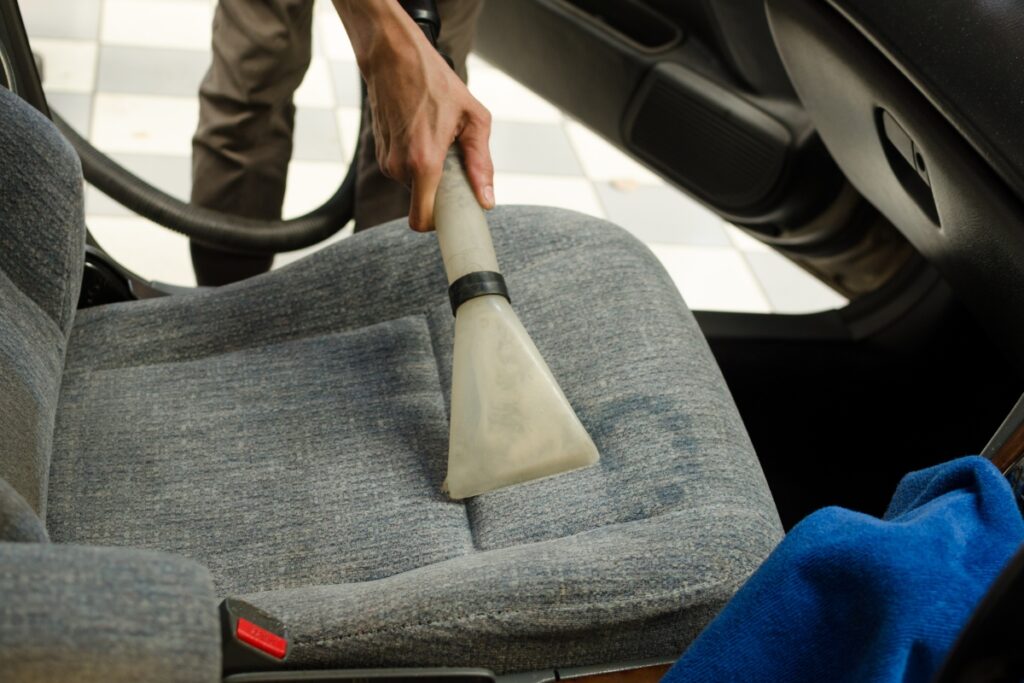
Mold on car seat doesn’t only look bad, but it also cause unpleasant odors and create some health issues. Whether it’s formed because of moisture or spills that remain uncleaned, mold can quickly take hold of your car’s upholstery.
In order to remain safe and healthy it’s necessary to remove mold from interior as soon as possible. But the question is how to do it properly?
Don’t worry we have got you covered. In this blog, we have comprehensively discussed 5 steps to Clean Mold Off Car Seats like a pro. Let’s get started:
1. How To Identify Mold on Car Seats?
a) What Does Mold on Car Seats Look Like?
Mold can appear as dark green, black, or even white spots on your car seats. It may also come with a musty odor, indicating that mold has started to grow in the fibers of the upholstery.
b) Common Causes of Mold Growth in Car Seats
Mold is typically caused because of:
- Warm and moist environments
- Spills
- Condensation
- Damp Weather
These causes of mold growth creates the perfect conditions for its growth.
2. How to Prepare Your Car for Mold Removal
a) Gather the Right Cleaning Supplies
To clean mold off car seats, you’ll need:
- Vacuum cleaner with brush attachment
- White vinegar or a mold-killing cleaning solution
- Spray bottle
- Soft-bristle brush
- Microfiber cloths
- Baking soda (optional for odor control)
- Protective gloves and mask (to avoid inhaling mold spores)
b) Ventilate the Car Properly
Before starting the cleaning process, it’s essential to ensure the area is well-ventilated. Open all the doors and windows of your car to allow fresh air to circulate and prevent the spread of mold spores inside the vehicle.
3. Steps to Clean Mold Off Car Seats
a) Start by Vacuuming the Seats
Begin by thoroughly vacuuming the car seats to remove loose mold spores, dirt, and debris. Use a vacuum cleaner with a brush attachment and gently run it over the affected areas, paying close attention to seams and crevices where mold can hide.
b) Spray the Mold-Killing Solution
Next, fill a spray bottle with either a mold-killing cleaning solution or a mixture of white vinegar and water (1:1 ratio). White vinegar is a natural mold killer that’s safe for most fabrics.
- Spray the solution generously over the moldy areas.
- Let the solution sit for about 10-15 minutes to penetrate the mold and break it down.
c) Scrub the Mold with a Soft-Bristle Brush
After the solution has had time to sit, use a soft-bristle brush to scrub the mold from the car seats. Be gentle to avoid damaging the upholstery while still working the cleaner into the fabric.
- Use circular motions to scrub.
- Repeat as needed for stubborn mold spots.
d) Wipe Away Excess Moisture
Once the mold has been scrubbed off, use a clean microfiber cloth to wipe away the excess cleaning solution and moisture. This step is crucial in preventing new mold from forming, as excess water can cause the mold to return.
4. How to Prevent Mold from Returning to Your Car Seats
a) Dry the Car Seats Thoroughly
After cleaning, it’s important to let the car seats dry completely to prevent any residual moisture from causing future mold growth.
- Open the car doors or windows and leave the vehicle in a sunny spot.
- You can also use a fan or dehumidifier to speed up the drying process.
b) Use Baking Soda for Odor Control
If mold has left an unpleasant odor in your car seats, sprinkle a light layer of baking soda over the upholstery. Baking soda is excellent for absorbing odors. Leave it for a few hours before vacuuming it up.
5. Regular Maintenance Tips to Keep Your Car Seats Mold-Free
a) Keep Your Car Ventilated
One of the best ways to prevent mold growth is by keeping your car well-ventilated. Crack open the windows on warm days and use air conditioning to reduce humidity levels inside the vehicle.
b) Clean Spills Immediately
Mold thrives in moist environments, so be sure to clean up any spills immediately. Keeping a microfiber cloth in your car for quick cleanups is an easy way to prevent moisture from seeping into your car seats.
c) Use Seat Covers for Added Protection
Using seat covers can protect your car seats from spills, moisture, and dirt, making it less likely for mold to develop. Opt for waterproof covers if possible for maximum protection.
Frequently Asked Questions:
What causes mold to grow on car seats?
Mold growth on car seats is typically caused by a combination of moisture, spills, and damp weather. Mold thrives in warm and humid environments, so it can develop when moisture from spills, condensation, or humid weather seeps into your car’s upholstery.
How can I tell if mold is on my car seats?
Mold on car seats often appears as dark green, black, or even white spots. You may also notice a musty odor, which is a common sign of mold growth. Pay attention to areas where moisture accumulates, such as seat seams and crevices.
Is it safe to clean mold off car seats myself?
Yes, it is safe to clean mold off car seats yourself, but it’s essential to wear protective gloves and a mask to avoid inhaling mold spores. Proper ventilation is also crucial to prevent spores from spreading inside the vehicle.
What cleaning products are best for removing mold from car seats?
A mold-killing cleaning solution or a mixture of white vinegar and water (in a 1:1 ratio) works well for cleaning mold off car seats. Vinegar is a natural, safe alternative to harsh chemicals and effectively kills mold.
How do I prevent mold from returning to my car seats?
To prevent mold from returning, make sure to dry your car seats thoroughly after cleaning. Use a fan or leave the car in a sunny spot to speed up the drying process. Keep your car well-ventilated and clean spills immediately to avoid excess moisture buildup.
Can I use baking soda to remove mold smells from my car seats?
Yes, baking soda can help absorb lingering odors caused by mold. Sprinkle a light layer of baking soda on the seats after cleaning, leave it for a few hours, and then vacuum it up.
How can I maintain mold-free car seats in the future?
Regular maintenance includes keeping your car ventilated, cleaning spills right away, and using seat covers to protect against moisture. Using a dehumidifier in the car can also help prevent excess moisture buildup.
How long does it take for mold to form on car seats?
Mold can begin to form within 24-48 hours in a warm, moist environment. The sooner you address spills and moisture, the less likely mold will have a chance to develop.
Is it necessary to remove the car seats to clean mold?
No, it’s not necessary to remove the car seats for cleaning. Mold can be effectively cleaned without removing the seats, though accessing hard-to-reach areas like seams may require more effort.
Can mold on car seats affect my health?
Yes, mold can cause respiratory issues, allergic reactions, and other health problems if left untreated. It’s important to remove mold promptly and take precautions when cleaning to protect your health.
Conclusion:
Cleaning mold off car seats is crucial not only for maintaining the appearance of your vehicle but also for your health. Mold can cause unpleasant odors, degrade your upholstery, and even lead to respiratory issues if left unchecked.
By following the steps outlined in this guide, you can effectively remove mold and prevent it from returning.
Regular maintenance, such as keeping your car well-ventilated, cleaning spills promptly, and using protective covers, will ensure that your car seats remain fresh and mold-free for the long term.





Pingback: How to Clean Car Seats Fabric Yourself: A Complete DIY Guide -